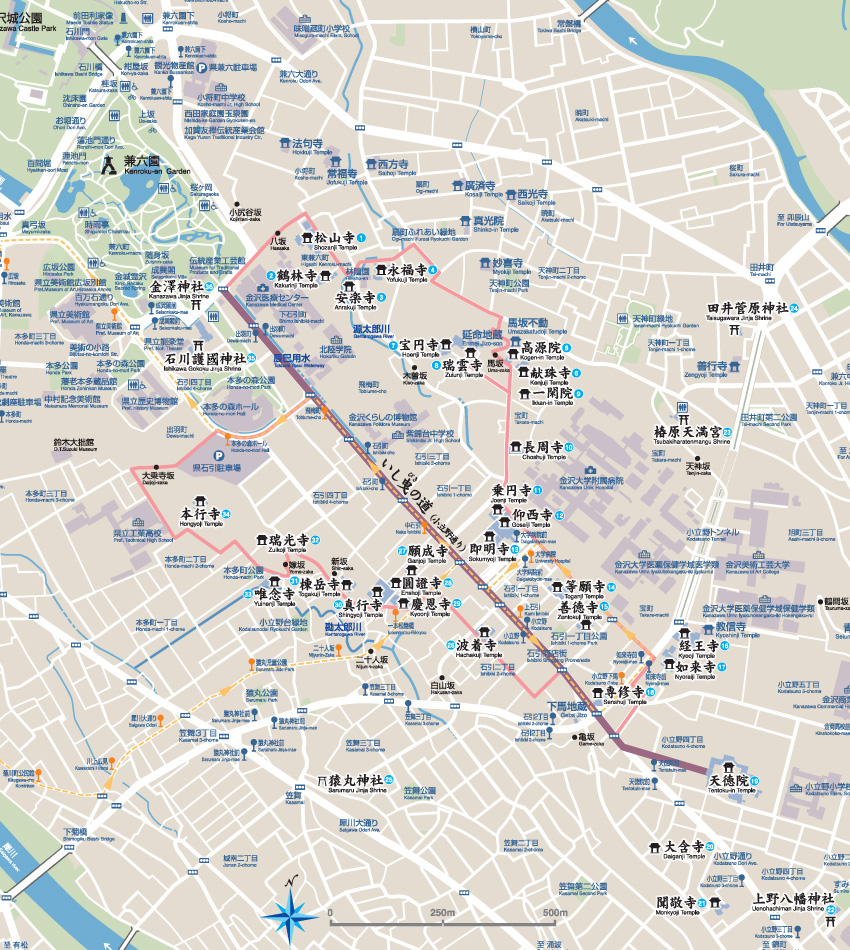Ishibiki-no-michi
Saigawa river and Asanogawa river run through Kanazawa in parallel. Kanazawa Castle was constructed at the tip of Kodatsuno Plateau, utilizing these two rivers as natural outer moats. Ishibiki-no-michi was a road used for carrying stones for stone walls at Kanazawa Castle after being quarried at Tomuro Mountain. It is said that temples related to Lord Maeda Family were put together along this road, including Hoenji Temple, Maeda’s family temple and Tentokuin Temple, which enshrines the grave of Tamahime, wife of Toshitune, the 3rd lord of Maeda. The area is very hilly with many slopes, still preserving elegant townscape. ‘Honda-no-mori’ –Honda forest – expanding to the southern slope of Kenrokuen garden is where the Honda family’s residence was located. Honda was the direct subordinate of Lord Maeda. Now the area is known as a sophisticated cultural zone with several museums including the Ishikawa Prefectural Museum of Art, Kanazawa Nakamura Memorial Museum and D.T. Suzuki Museum.

About the three temple districts in Kanazawa
Around 1616 (Genna 2), Maeda Toshitsune, the 3rd generation of Lord Maeda of the Kaga clan, relocated and stationed temples and shrines around the town in three areas in hopes of protecting Kanazawa Castle, managing temples and shrines, investigating family register as well as taking countermeasures against Ikkoshu. The three areas are ‘Kodatsuno Temple district’, the southeastern part of the castle, ‘Utatsuyama Temple district’, the northeastern part, and ‘Teramachi Temple district’, the southwestern part. Each district has a different feel to it. Please choose one to explore.
D.T.Suzuki Museum
Know, learn and think.
D. T. Suzuki was a prominent Buddhist philosopher born in Kanazawa. This museum is the best place to encounter his life and thought.
The D. T. Suzuki Museum is an ideal place for visitors both inside and outside Japan to deepen their understanding of the ideas and the achievements of Daisetz Suzuki, a prominent Buddhist philosopher who was born in Kanazawa, and is also a place for self-reflection. The museum consists of three wings connected by corridors: an Entrance Wing, an Exhibition Wing and a Contemplative Wing, and three gardens: the Vestibule Garden, the Water Mirror Garden and the Roji Garden. Visitors can learn about the philosophy of Daisetz Suzuki and engage in their own contemplation as they move through the wings and gardens.
Encounter the history while walking up and down slopes.
There are three temple areas in Kanazawa, sandwiched by the Sai river and the Asano river. The Kodatsuno temple area has many slopes. A straight road extends southeast toward the Ishibiki-Kodatsuno area and the surrounding area has some complicated curved land, such as moderate slopes or steep stairs for shortcuts, offering the same atmosphere as the people who live here. Walking down the slope, it is fun to find a magnificent view among the trees grown on the hill. “Hassaka ” was named after the eight slopes used by loggers. “Kisozaka” was named after the secluded area in the mountain in Kiso.
On “Umasaka”, where farmers used to use horses, there stands a God of Fire which is believed to help you see. “Nijunin (20 people) zaka” was named thus because a group of 20 foot soldiers lived around here.
The slope from Kodatsuno to Hondamachi area was constructed by Shinohara Dewanokami to make a route for carrying his daughter’s household effects. In the Kodatsuno Temple Area you can enjoy walking slopes,and enjoy reading about the heartwarming history of this area.

